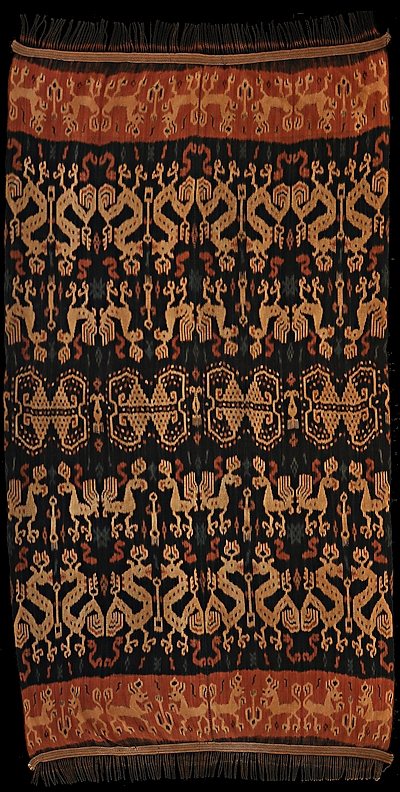| |
 
 | | | |
322 Sumba, East Sumba
Hinggi (men's blanket)  
| | Locale: | Kanatang | | Period: | Early 20th | | Yarn: | Cotton, hand-spun, fine, double-ply | | Technique: | Warp ikat | | Panels: | 2 | | Size: | 125 x 237 cm (4' 1" x 7' 9") LW: 1.90 | | Weight: | 1020 g (36.0 oz), 344 g/m2 (1.13 oz/ft2) | | Design: | High class hinggi with a bold seven band field division, which allows the depiction of large dragons in the the widest bands, snakes crawling between their tails, and substantial cockatoos, a hallmark of Kanatang. The central band carries four karihu motifs. The design suggest 16-fold replication but small devices, keys, prove this impression to be erroneous. Axial asymmetry was created by small differences in the karihu motifs on the axis, as well as by the placement of double eagle motifs on the axis. This is a lima varna hinggi: the clearly demarcated touches of yellow (a royal prerogative) were added by means of Method 2 ndatta. | | Comment: | Pusaka from the collection of a West-, not East-Sumban royal family. It was the property of Umbu Nay Kota, King of Mamborro and his ancestors for close to a hundred years and in nearly as new condition, with deeply saturated colours. Divestments of pusaka are sometimes made to advance the family's substance and status, letting go something from the past to make an investment in the future. Several of the high end hinggi in this, and probably in all substantial collections, were offered to collectors and dealers abroad specifically to pay for a younger generation's education. It was never for a motorbike, a flats creen, stuff. Indeed, a transfer took place, a transaction of a material nature, but it remained in the same realm: that of culture and learning. This makes it somehow less hurtful, more fair, more even. They let us have some of their past, we give them some of their future. | | Background: | Chapters on Sumba and East Sumba. | | Published: | Ikat from Timor and its Outer Islands, 2022.
Noble Virtuosity: Hidden Asymmetry in Ikat from Sumba, 2024. | | Compare: | 017 | | |

©Peter ten Hoopen, 2025
All rights reserved.
|
|


